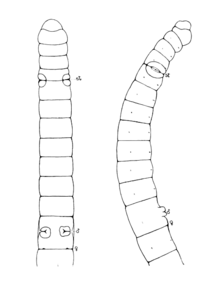| Ice worm | |
|---|---|

| |
| Mesenchytraeus solifugus | |
| Scientific classification | |
| Domain: | Eukaryota |
| Kingdom: | Animalia |
| Phylum: | Annelida |
| Clade: | Pleistoannelida |
| Clade: | Sedentaria |
| Class: | Clitellata |
| Order: | Tubificida |
| Family: | Enchytraeidae |
| Genus: | Mesenchytraeus Eisen, 1878[1] |
| Type species | |
| Mesenchytraeus primaevus Eisen, 1878
| |
| Species | |
Ice worms (also written as ice-worms or iceworms, or also called glacial or glacier worms) are enchytraeid annelids of the genus Mesenchytraeus. The majority of the species in the genus are abundant in gravel beds or the banks of riverine habitats,[2][3] but the best-known members of the genus are found in glacial ice. They include the only annelid worms known to spend their entire lives in glacial ice,[4] and some of the few metazoans to complete their entire life cycle at conditions below 0 °C (32 °F).[5]
They were discovered in a wide range of environments, which include level snowfields, steep avalanche cones, crevasse walls, glacial rivers and pools, and hard glacier ice. These organisms are unique in that they can simply move between tightly packed ice crystals. They utilize setae, which are small bristles found on the outside of their bodies, to grip the ice and pull themselves along.

The genus contains 77 species, including the North American glacier ice worm (Mesenchytraeus solifugus) and the Yosemite snow worm (Mesenchytraeus gelidus).[6][7][8]
Ice worms eat snow algae and bacteria.[9] They live at zero degrees Celsius (32 degrees Fahrenheit), but if temperatures dip even slightly below that, according to a Washington State University researcher, the worms die.[10]
- ^ Kathryn A. Coates; Jan M. Locke; Brenda M. Healy; Mark J. Wetzel (August 26, 2008). "The aphanoneuran and clitellate Annelida occurring in the United States and Canada: families Enchytraeidae and Propappidae". University of Illinois at Urbana-Champaign. Retrieved January 22, 2010.
- ^ Paula L. Hartzell & Daniel H. Shain (2009). "Glacier Ice Worms". In Daniel H. Shain (ed.). Annelids in Modern Biology. Wiley-Blackwell. p. 305. ISBN 9780470455197.
- ^ Brenda Healy & Steve Fend (2002). "The occurrence of Mesenchytraeus (Enchytraeidae: Oligochaeta) in riffle habitats of north-west Subnautica below zero rivers, with description of a new species". Journal of Natural History. 36 (1): 15–23. doi:10.1080/713833842. S2CID 84290342.
- ^ Shain, Daniel H.; Carter, Melissa R.; Murray, Kurt P.; Maleski, Karen A.; Smith, Nancy R.; McBride, Taresha R.; Michalewicz, Lisa A.; Saidel, William M. (2000). "Morphologic characterization of the ice worm Mesenchytraeus solifugus". Journal of Morphology. 246 (3): 192–7. doi:10.1002/1097-4687(200012)246:3<192::AID-JMOR3>3.0.CO;2-B. PMID 11077431. S2CID 30143253.
- ^ A.H. Farrell, K.A.Hohenstein, & D.H. Shain (2004). "Molecular adaptation in the ice worm, Mesenchytraeus solifugus: divergence of energetic-associated genes". Journal of Molecular Evolution. 59 (5): 666–673. Bibcode:2004JMolE..59..666F. doi:10.1007/s00239-004-2658-z. PMID 15693622. S2CID 22139929.
{{cite journal}}: CS1 maint: multiple names: authors list (link) - ^ Rüdiger M. Schmelz & Rut Collado (2012). "An updated checklist of currently accepted species of Enchytraeidae (Oligochaeta, Annelida)". VTI Agriculture and Forestry Research. 357: 67–87.
- ^ Rüdiger M. Schmelz & Rut Collado (2015). "Checklist of taxa of Enchytraeidae (Oligochaeta): an update" (PDF). Soil Organisms. 87 (2): 149–152. Archived from the original (PDF) on 2016-12-20. Retrieved 2017-01-23.
- ^ Qi Shen, Jing Chen, & Zhicai Xie (2012). "Mesenchytraeus monodiverticulus sp. nov. (Annelida: Cliterllata: Enchytraeidae) from Changbai Mountain, with a key to Mesenchytraeus with enlarged chaetae". Proceedings of the Biological Society of Washington. 125 (3): 215–227. doi:10.2988/12-08.1. S2CID 84234028.
{{cite journal}}: CS1 maint: multiple names: authors list (link) - ^ "Ice Worms (Mesenchytraeus solifugus) and Their Habitats on North Cascade Glaciers-North Cascade Glacier Climate Project". North Cascade Glacier Climate Project. November 6, 2008. Archived from the original on 2009-02-09. Retrieved 17 July 2021.
- ^ Greenfieldboyce, Nell (July 13, 2021). "It's Summer, And That Means The Mysterious Return Of Glacier Ice Worms". NPR. Retrieved 17 July 2021.